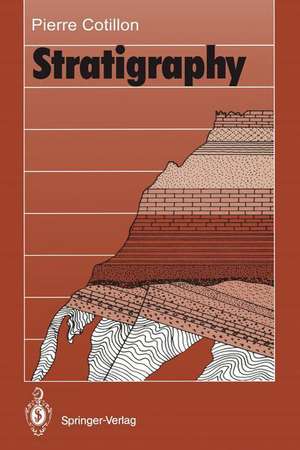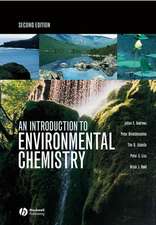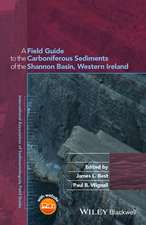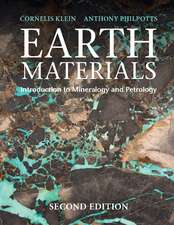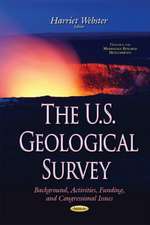Stratigraphy
Traducere de J. P. A. Noble Autor Pierre Cotillonen Limba Engleză Paperback – 20 sep 1992
Preț: 440.54 lei
Preț vechi: 543.88 lei
-19% Nou
Puncte Express: 661
Preț estimativ în valută:
84.31€ • 91.55$ • 70.82£
84.31€ • 91.55$ • 70.82£
Carte tipărită la comandă
Livrare economică 18-24 aprilie
Preluare comenzi: 021 569.72.76
Specificații
ISBN-13: 9783540546757
ISBN-10: 3540546758
Pagini: 200
Dimensiuni: 155 x 235 x 11 mm
Greutate: 0.29 kg
Ediția:Softcover reprint of the original 1st ed. 1992
Editura: Springer Berlin, Heidelberg
Colecția Springer
Locul publicării:Berlin, Heidelberg, Germany
ISBN-10: 3540546758
Pagini: 200
Dimensiuni: 155 x 235 x 11 mm
Greutate: 0.29 kg
Ediția:Softcover reprint of the original 1st ed. 1992
Editura: Springer Berlin, Heidelberg
Colecția Springer
Locul publicării:Berlin, Heidelberg, Germany
Public țintă
Lower undergraduateDescriere
Stratigraphydefines
the
basis,
concepts
and
methods
of
one
of
the
oldest
disciplines
of
Earth
Sciences.
Stratigraphy
is
a
primary
tool
in
dynamical
and
historical
reconstructions
in
paleogeography,
paleontology,
tectonics,
sedimentology
as
well
as
mineral
prospecting.
The
first
three
chapters
are
devoted
to
the
description
of
the
main
tools
used
to
subdivide
geological
time
and
to
construct
a
more
precise
chronologic
scale.
During
this
century
this
approach
has
been
closely
associated
with
the
progress
yielded
by
geochemistry,
geophysics,
plate
tectonics,
petroleum
exploration
and
the
Deep
Sea
Drilling
Program.
Correlation
and
dating,
leading
to
reconstructions
of
paleogeography
-
a
major
step
toward
the
knowledge
of
Earth
history
-
is
included.
In
a
last
chapter
the
principal
stages
of
geohistory
are
described.
Epoch
for
epoch
plate
dynamics,
sea
level
and
climate
variations,
environmental
characters
on
continents
and
in
oceans,
and
the
link
between
cyclic
interval
activity,
cosmic
events
and
Earth
history
during
the
last
900
million
years
are
outlined.
Stratigraphical
methods
are
then
presented
at
their
different
scales
of
observation
and
synthesis.
Cuprins
1
Fundamentals
of
Stratigraphy.-
1
Definitions.-
2
Chronology
of
Events.-
3
Principles
of
Correlation.-
2
Elaboration
of
the
Fundamentals
of
Stratigraphy.-
1
Lithostratigraphy.-
2
Biostratigraphy.-
2.1
Evolution,
the
Reference
System
for
Age
Dating.-
2.2
The
Zone
Concept
of
Oppel.-
3
Chronostratigraphy.-
3.1
The
Concept
of
the
Stage.-
3.2
Event
Stratigraphy.-
3.3
The
General
Chronostratigraphic
Scale.-
4
Conclusions.-
3
Modern
Stratigraphy.-
1
Refinement
of
Concepts
and
Time
Scales.-
1.1
Evaluation
of
Geologic
Time
Intervals
and
Rates.-
1.2
New
Biostratigraphic
Approaches.-
1.3
Search
for
a
Rigorous
and
Universal
Chronostratigraphy.-
2
New
Methods
of
Correlation.-
2.1
Correlation
by
Sedimentary
Rhythms.-
2.2
Correlation
by
Mineralogic
and
Geochemical
Markers.-
2.3
Correlation
by
Paleomagnetism.-
2.4
Extraterrestrial
Correlations.-
2.5
Conclusions.-
4
From
Stratigraphy
to
Paleogeography.-
1
Principles
and
Methods
of
Paleogeography.-
1.1
Facies.-
1.2
Paleobiogeography.-
1.3
Cartographic
Syntheses.-
2
Factors
of
Paleogeographic
Evolution.-
2.1
Deformation
of
the
Lithosphere.-
2.2
Volcanic
Eruptions.-
2.3
Interplay
of
Erosion
and
Sedimentation.-
2.4
Eustasy.-
2.5
Polar
Wandering.-
2.6
Conclusions:
the
Earth
in
Relation
to
Other
Planets
of
the
Solar
System.-
5
The
Major
Stages
of
Earth
History.-
1
The
Precambrian.-
1.1
Boundaries
and
Subdivisions.-
1.2
Methods
of
Study.-
1.3
The
Geography
of
the
Precambrian.-
1.4
Early
Segregation
and
Establishment
of
Fundamental
Processes.-
1.5
Conclusions
on
the
Precambrian.-
2
The
Paleozoic:
the
Formation
of
Pangea.-
2.1
Lower
Paleozoic.-
2.2
Upper
Paleozoic.-
3
The
Mesozoic
and
Cenozoic:
Breakup
of
Pangea.-
3.1
The
Mesozoic.-
3.2
The
Cenozoic.-
3.3
Conclusions
on
the
Mesozoic
and
Cenozoic.-
General
Conclusions.-
References.
